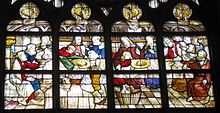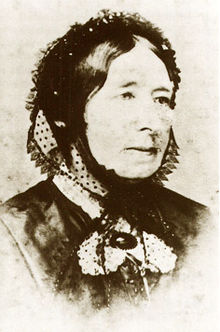Westphalian cuisine
The Westphalian cuisine is one of the regional cuisines in Germany . Their characteristics are an expression of the scenic and historical characteristics of Westphalia .
The Westphalian cuisine is in the broader sense a part of the North German cuisine, i. In other words, it is part of the cooking traditions that are typical for Germany north of the “ white sausage equator ”. Westphalian cuisine also knows the northern German combination of fatty, sweet and warm, but not as pronounced as in Lower Saxony or Schleswig-Holstein (other general northern German specialties include: kale, red cabbage instead of blue cabbage, little lard, little Garlic). The Westphalian cuisine is an inland cuisine. Fish plays a subordinate role in it. In addition to the Lower Saxony region, there are also closer regional references to theDutch and Rhenish cuisine .
The so-called " Westphalian Last Supper " in the Wiesenkirche in Soest is well known . Jesus and his disciples celebrate the Lord's Supper on this old glass window with ham, dark bread, pig's head, schnapps and beer.
Meat dishes
Westphalian meat dishes are the Pfefferpotthast, already mentioned in a Dortmund chronicle in the 14th century , and Panhas , a meat pie with buckwheat flour . Töttchen is boiled veal with an onion and mustard sauce and is particularly common in the Münsterland . Möppkenbrot ( ndt . : Möpkenbraut) is a blood sausage specialty that is widespread in central Westphalia, from the northern Sauerland , over the Hellwegbörden to the Osnabrücker Land and Tecklenburger Land . The preparation of “ broad beans ” with bacon is also typical of Westphalia . Potthucke and bone sausage are known in the Sauerland .
Another dish is blind chicken , the tradition named after so because even a blind hen in this stew needs to find something good. Onion meatbread rolls are popular at any time of the day. In the western Münsterland there is the Knockepott . Many of these dishes were traditionally served to use leftovers shortly after slaughter , often at so-called slaughter festivals to which all members and helpers of a farm and often the neighbors were invited.
Bakery products
The dark, malty wholemeal pumpernickel bread has its origins in Westphalia. The mare guy is baked in the Advent season . In Westphalia, a white clay pipe is always added to the bread made from yeast dough . The Struwen , a fried yeast dough with raisins that the Rhineland is also familiar with, is also widespread . About the Country lip is also the Pickert , a kind of potato pancake , combined with the Westphalian kitchen. The rye mixed bread Paderborn country bread is known nationwide .
Alcoholic drinks
Westphalian beer is widespread , today mostly as a pilsner : In addition to more regionally oriented breweries with brands such as Detmolder in East Westphalia-Lippe , Barre in Lübbecke , Moritz Fiege in Bochum or the Pinkus organic beer ( Münsterland ), there are also the big ones in Westphalia Companies of the brands Warsteiner , Veltins (both in the Sauerland ), Herford (in East Westphalia-Lippe ) and Krombacher (in the Siegerland ). Dortmund was once the city with the largest beer output in Germany and Europe , benefiting from the demand from the Ruhr area . Well-known brands here are DAB , Dortmunder Kronen and Brinkhoff's . Historically, top-fermented Altbier was mainly brewed in Westphalia until the 19th century . From 1843, the Dortmunder Helle appeared on the market, a bottom-fermented export beer that soon enjoyed high demand. Important spirits are the Steinhäger and, as in all of Northern Germany, the wheat and rye grain ( grain brandy ).
ham
The Westphalian ham , which has been produced in the Münsterland lowlands, in the Osnabrücker Land, in the Sauerland and in the Grafschaft Bentheim since the early Middle Ages , is available in smoked and air-dried form, but it is never as heavily smoked or dark as the Black Forest ham . In Meschede in the Sauerland, Sauerland ham has been produced in a family tradition since the 18th century . Furthermore, one of the centers of German sausage production is located in Versmold .
Others
Henriette Davidis from Wetter-Wengern was a famous cook of Westphalian origin . In her cookbook, which is very influential for German cuisine, there are several dishes of Westphalian origin (e.g. Pfefferpotthast) and numerous dishes from many other regions.
A distinction must be made between the Westphalian cuisine in the traditional sense and its own food traditions in the Ruhr area . Here, Panhas and Pfefferpotthast have been joined by the traditional dishes of the immigrants, such as Königsberger Klopse from East Prussia or the branding of broad beans from the Silesian cuisine. A classic, not only in the Westphalian Ruhr area, is the Schlabberkappes . The currywurst sung by Herbert Grönemeyer , the “ manta plate ” or “ fries bar ” have meanwhile become known beyond the typical regional language.
Many of the dishes and dishes listed here are rarely used today. Where rural traditions have not been preserved, Westphalian cuisine is often limited to tourist gastronomy (although, on the other hand, many of the “Westphalian” dishes offered in gastronomy are new creations with a more or less strong regional influence). However, especially in the meat product sector, at least one of the typical regional preparations such as Möpkenbrot, beef sausage, cabbage sausage (winter), panhas, liver or sausage bread is available in most local butcher shops . Westphalian Mettendchen are generally known and appreciated in the region . Pumpernickel and Westphalian beer have spread internationally.
Typical traditional dishes
- Apple in puff pastry
- Blind chicken
- Blood vegetables
- Bread pancakes
- Blushing girl
- barley soup
- Gray beans with bacon - stew with broad beans, pork and potatoes
- Hare pepper
- Heaven and Earth
- Nibble
- Liver bread
- Nieheimer cheese
- Panhas
- Pill chewers
- Pfefferpotthast
- Danish milk
- Pumpernickel soup
- Salt cake
- Sauerbraten
- Ham burial
- Slag sausage
- Spanish Fricco , also in the spelling "Frikko" / "Frico"
- Gruel
- Struwen
- Stick sauce stew
- Westphalian beef sausage
- Westphalian rosary
- Wort pot
- Sausage porridge
- Sausage bread
- Westphalian iron waffles
literature
- Willi Krift: That's how we cooked in Westphalia back then . Contributions to popular culture in north-west Germany. F. Coppenrath Verlag, Münster 1986. ISBN 3-88547-295-3 ( full text as PDF )
- Erich Alewelt: Keär man is dat Lecka - recipes from Westphalian cuisine . Ardey-Verlag, 2002, ISBN 3-87023-999-9
- Westphalian cuisine. The best recipes. Compact Mini Recipes, ISBN 3-8174-3209-7
- Desire for enjoyment. Cultural history of eating and drinking in Westphalia , main topic in the magazine Westfalenspiegel , 6/2003, pp. 14–28
- Ira Schneider: Ostwestfalen-Lippe, kitchen classics. Wartberg Verlag, 2015, ISBN 978-3-8313-2475-0 .
- Westfälischer Heimatbund (ed.): Yearbook Westphalia 2012. Westphalia culinary. Aschendorff Verlag, Münster 2011, ISBN 978-3-402-15818-0 .
Web links
Individual evidence
- ↑ Eckhard Supp : Duden. Dictionary culinary arts. From amuse-bouche to decorative snow . Dudenverlag, Mannheim a. a. 2011, ISBN 978-3-411-70392-0 , Chapter: Regional dishes in German-speaking countries , p. 88 .


